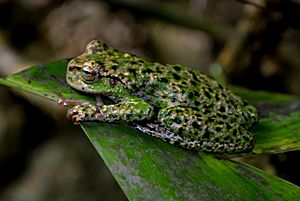Plectrohyla acanthodes facts for kids
Quick facts for kids Plectrohyla acanthodes |
|
|---|---|
 |
|
| P. acanthodes in Chiapas, Mexico | |
| Conservation status | |
| Scientific classification |
The Plectrohyla acanthodes is a special type of frog often called the thorny spikethumb frog. It belongs to the Hylidae family, which includes many tree frogs. This frog is unique because of its "thorny" appearance, though it's not actually sharp or dangerous to touch.
These interesting frogs live in parts of Guatemala and Mexico. They prefer cool, wet places like montane forests, which are forests found in mountains. They also like to live near rivers. Sadly, the thorny spikethumb frog is currently in danger because its home is disappearing.
Contents
About the Thorny Spikethumb Frog
The thorny spikethumb frog was first described by scientists William E. Duellman and Jonathan A. Campbell in 1992. It's a relatively new discovery in the world of frogs! Like all frogs, it starts its life as a tiny egg, usually laid in water. Then, it hatches into a tadpole, which is a small, fish-like creature that lives in the water. As it grows, the tadpole slowly changes, developing legs and losing its tail, until it becomes an adult frog that can live on land and in water.
Where Do Thorny Spikethumb Frogs Live?
These frogs are found in specific regions of Central America. Their natural habitats are very important for their survival. They need subtropical or tropical moist montane forests. This means they live in warm, wet forests that are high up in the mountains. The moisture from these forests and the nearby rivers are crucial for them. Frogs need water to keep their skin moist and for their reproduction cycle.
Why Are These Frogs Important?
Every animal plays a role in its ecosystem, and the thorny spikethumb frog is no different. Frogs are often considered "bioindicators." This means they can tell us about the health of an environment. If frogs are doing well, it usually means the environment is healthy. If frog populations are declining, it can be a sign that something is wrong with the habitat, like pollution or habitat loss.
Threats to Their Survival
Unfortunately, the thorny spikethumb frog is listed as an endangered species. The biggest threat to this frog is habitat loss. This happens when the forests where they live are cut down or changed by human activities. When their homes are destroyed, these frogs lose the places they need to find food, reproduce, and stay safe. Protecting their forest homes is very important to help these unique frogs survive for future generations.
See also
 In Spanish: Plectrohyla acanthodes para niños
In Spanish: Plectrohyla acanthodes para niños


